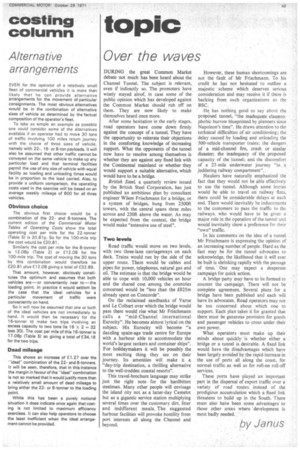Over the waves
Page 91

If you've noticed an error in this article please click here to report it so we can fix it.
DURING the great Common Market debate not much has been heard about the Channel Tunnel. The subject is relevant, even if indirectly so. The promoters have wisely stayed aloof, in case some of the public opinion which has developed against the Common Market should rub off on them. They are now likely to make themselves heard once more.
After some hesitation in the early stages, road operators have come down firmly against the concept of a tunnel. They have the opportunity to reiterate their objections in the comforting knowledge of increasing support. What the opponents of the tunnel now have to resolve among themselves is whether they are against any fixed link with the Continental mainland or whether they would support a suitable alternative, which would have to be a bridge.
British Steel, a quarterly review issued by the British Steel Corporation, has just published an ambitious plan by consultant engineer Wilem Frischmann for a bridge, or a system of bridges, hung from 2500ft towers, with the central spans three miles across and 230ft above the water. As may be expected from the context, the bridge would make "extensive use of steel".
Two levels
Road traffic would move on two levels, with two three-lane carriageways on each deck. Trains would run by the side of the upper route. There would be cables and pipes for power, telephones, natural gas and oil. The estimate is that the bridge would be able to cope with 10,000 vehicles an hour and the shared cost among the countries concerned would be "less than the £825m already spent on Concorde".
On the reclaimed sandbanks of Varne and Le Colbart over which the bridge would pass there would rise what Mr Frischmann calls a "mid-Channel international Eurocity". He becomes almost lyrical on the subject. His Eurocity will become "a dazzling space-age trade centre for Europe with a harbour able to accommodate the world's largest tankers and container ships". For holidaymakers it will be possibly the most exciting thing they see on their journey. Its amenities will make it a "day-trip destination, a thrilling alternative to the well-trodden coastal resorts".
This travel-brochure language may strike just the right note for the hardbitten steelman. Many other people will envisage the island city not as a latter-day Camelot but as a gigantic service station multiplying several times over the customary dirt. litter and indifferent meals. The suggested harbour facilities will provoke hostility from port interests all along the Channel and beyond. However, these human shortcomings are not the fault of Mr Frischmann. To his credit he has not hesitated to outline a majestic scheme which deserves serious consideration and may receive it if thtre is backing from such organizations as the BSC.
He has nothing good to say about the proposed tunnel, "the inadequate claustrophobic burrow blueprinted by planners since Napoleon's time". He draws attention to the technical difficulties of air conditioning; the delay caused by loading and unloading the 300-vehicle transporter trains; the dangers of a mid-channel fire, crash or similar disaster, the inadequacy of the proposed capacity of the tunnel; and the discomfort of a 23-mile underwater journey "in a juddering railway compartment"., Hauliers have naturally emphasized the fact that they would not be able effectively to use the tunnel. Although some lorries would be able to travel on railway flats, there could be considerable delays at each end. There would inevitably be inducements to the customers to pass the traffic to the railways, who would have to be given a major role in the operation of the tunnel and would inevitably show a preference for their "own" traffic.
In his comments on the idea of a tunnel Mr Frischmann is expressing the opinion of an increasing number of people. Hard as the fact may be for the tunnel advocates to acknowledge, the likelihood that it will ever be built is shrinking rapidly with the passage of time. One may expect a desperate campaign for quick action.
A bridge party may have to be formed to counter the campaign. There will not be complete agreement. Several plans for a bridge have been published and each will have its advocates. Road operators may not be too concerned about which one to support. Each plan takes it for granted that there must be generous provision for goods and passenger vehicles to cross under their own power.
What operators must make up their minds about quickly is whether either a bridge or a tunnel is desirable. A fixed link would have the disadvantages which have been largely avoided by the rapid increase in the use of ports all along the coast, for normal traffic as well as for roll-on roll-off services.
These ports have played an important part in the dispersal of export traffic over a variety of road routes instead of the prodigious accumulation which a fixed link threatens to build up in the South. There must also have been some advantages to those other areas where 'development is most badly needed.
by Janus












































































































































